


This Month in Aviation History
Aircraft of the Month for November 2000
Dassault-Breguet Mirage 4000
by Alex Stoll
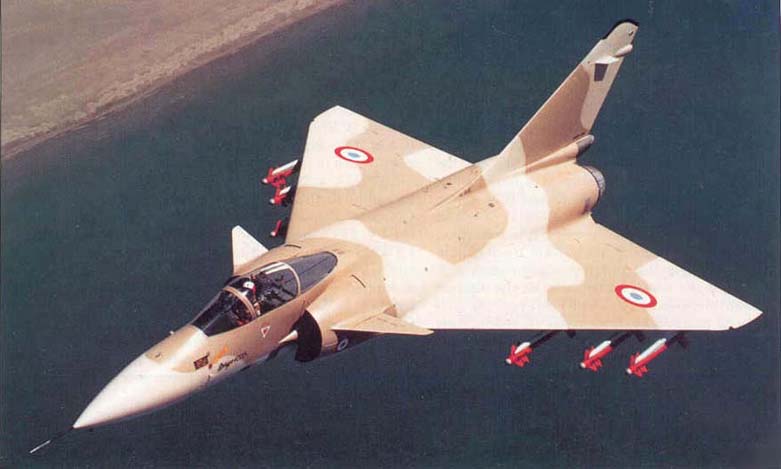





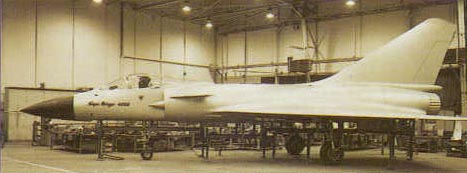
On its first flight, on 9 March 1979 at Istres, it reached Mach 1.2, piloted by Jean-Marie Saget. It reached Mach 1.6 on its second flight and, on its sixth flight (on 11 April), it reached Mach 2.04 and flew at angles of attack of up to 25° during a spin analysis. It performed that June at the Paris airshow. At the end of 1980, the aircraft had about 100 flying hours. M53-5 engines were added by 1981, replaceing the -P2s. In 1982 it flew in interceptor and attack configurations at Farnborough.

Configuration
The Mirage 4000 made use of computer-derived aerodynamics, with a fly-by-wire active control system and a rearward CG. It was designed to be easy to maintain on forward airfields. It also had variable-incidence sweptback foreplanes and a blister-type cockpit canopy with a 360° FOV. Boron and carbon fiber composites were used extensively in the fin, rudder, elevons, fuselage access panels, foreplanes, and other parts. The wings had large-radius root fairings. The entire trailing edge of each wing was taken up by two-section elevons. Variable camber was provided by automatic full-span leading-edge flaps. The rear fuselage was shorter, which made Karman fairings unneccessary. The rudder, elevons, and flaps were actuated by the fly-by-wire control system. The vertical fin was made of carbon composite and contained fuel tanks, which helpd to give the 4000 about three times as much internal fuel as the Mirage 2000 (other fuel tanks were in the wings and fuselage). The fuselage was of conventional semi-monocoque structure. Door-type airbrakes were located in each intake trunk above the wings' leading edges. The tricycle landing gear was designed by Messier-Hispano-Bugatti and had twin nosewheels and a single wheel on each main unit. Each intake had a moveable half-cone centerbody. The two M53s provided a thrust-to-weight ratio of above 1:1 - if it had entered service, it would have been equivalent to the F-15 or the Su-27.
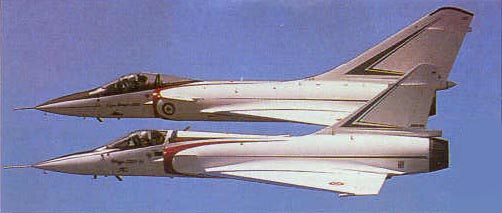
When possible, systems and avionics were adapted from the Mirage 2000. The hydraulic system was made by Messier-Hispano-Bugatti, and was pressurized to 280 bars (4,000 lb/sq in). It was powered by four advanced pumps and used lightweight titanium pipelines. The Mirage 4000 also used two Auxilec electric generators. In a compartment behind the pilot was a Turboméca Palouste gas turbine APU (to start the engines). The prototype used the same RDM multi-mode Doppler radar as the Mirage 2000, but a radar as big as 80 cm (31.5 in) in diameter could fit in the very large nose radome. Other avionics included a digital autopilot, multi-mode displays, a SAGEM Uliss 52 INS, a Crouzet Type 80 air data computer, a Thomson-CSF VE-130 HUD, and a digital automated weapon delivery system.
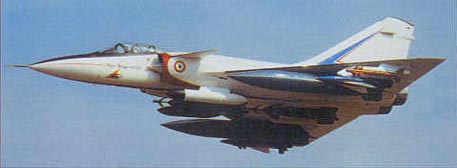
Sales
By the time that the mock-up was displayed, Saudi Arabia had been funding development, and by 1980, Defense Minister Prince Sultan Ubn Abdul Aziz said that they were considering acquiring them. France's defense committee ruled that 50 Mirage 4000s should be acquired to replace the Mirage IV. However, no orders materialized, mainly because of its high cost (and because the Mirage 2000 was a better value). In 1986, Dassualt re-activated the Mirage 4000 (and renamed it 'Mirage 4000,' from 'Super Mirage 4000') and re-painted it with desert camouflage on the upper surfaces. It was used as a chase plane and a testbed for the Rafale program (researching the behaviour of a canard-delta configuration in turbulence). It appeared at Paris in 1987. In 1995 it was transferred to Paris again as a permanent exhibit outside the Musée de l'Air et de l'Espace.

Dassault-Breguet Mirage 4000 Specifications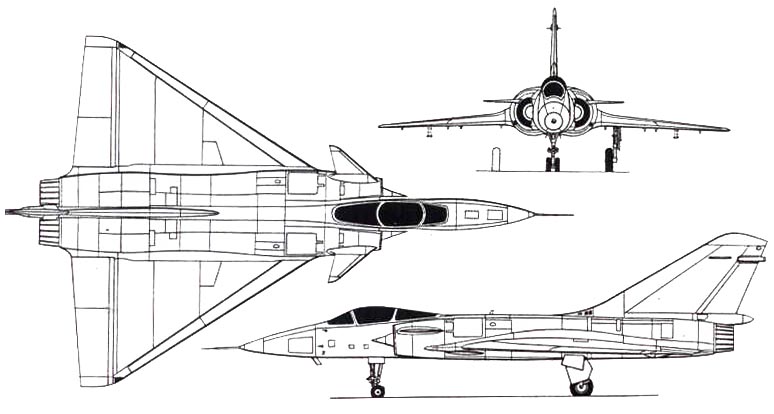 | |
| Type | Multirole combat aircraft |
| Powerplant | Two 22,046 lb thrust SNECMA M53 afterburning turbofans |
| Accommodation | Pilot only, on a Martin-Baker F10R zero-zero ejection seat, under a starboard-opening transparent canopy (a two-seat version was under study) |
| Armament | Two 30-mm DEFA cannon in lower air intakes plus twelve hardpoints (six underfuselage, six underwing, and one centerline) allowing carriage of up to 8,000kg (17,620 lb) of stores including bombs, AAMs and ASMs such as Magics and Exocets, rocket pods, or a buddy refueling pod. 2550 L (550 Imp gal) drop tanks could be located under each wing and on the centerline. The 4000 carried two fuel tanks, two Sycamor jamming pods, two Magic AAMs, a laser designator, two AS30Ls, two 1000kg LGBs, and a podded Antilope radar during the 1928 Farnborough airshow |
| Performance | |
|---|---|
| Max speed | Mach 2.3 (2333 km/h / 1260 kts / 1450 mph) at altitude |
| Service ceiling | 20,000m (65,600 ft) |
| Radius w/ fuel tanks and recce pod | 1850km (100 nm/1150 mi) |
| Initial Climb Rate | 18,300 m/min (60,024 ft/min) |
| Dimensions | |
| Wingspan | 12m (39 ft 4.5 in) |
| Length | 18.7m (61 ft 4.25 in) |
| Height | 5.8m (19 ft) |
| Wheelbase | 6.9 m (22 ft 7.5 in) |
| Wheel track | 4.36 m (14 ft 3.5 in) |
| Wing area | 73m² (786sq ft) |
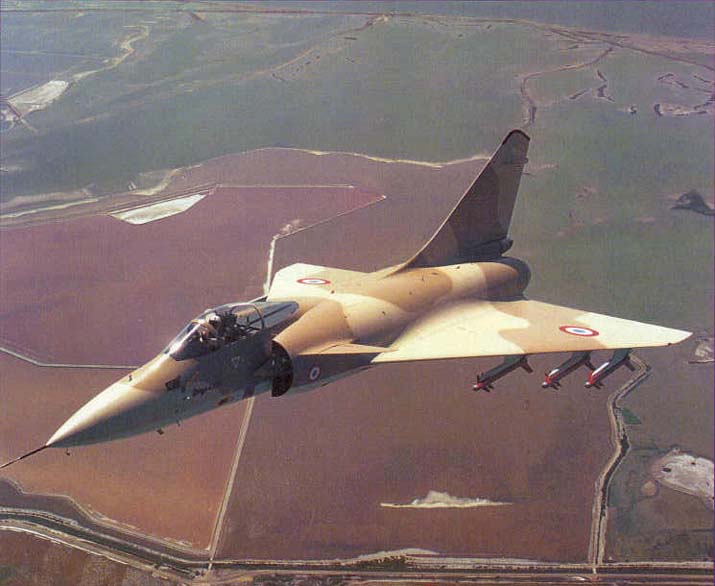
|
1 Nov 1985 - Alex Stoll was born 2 Nov 1947 - First flight of the Spruce Goose 2 Nov 1995 - First flight of the Fokker 60 Utility 4 Nov 1968 - First flight of the L-39 prototype 8 Nov 1976 - First flight of the CL-600 9 Nov 1950 - The USN's first jet-jet victory: A F9F downed a MiG-15 9 Nov 1956 - First flight of the production Javelin F(AW).7 9 Nov 1978 - First flight of the YAV-8B 10 Nov 1982 - First flight of the Mi-28 11 Nov 1956 - First flight of the YB-58 11 Nov 1983 - First flight of the Spanish CN-235 12 Nov 1970 - First flight of the XC-1 prototype 17 Nov 1956 - First flight of the Mirage III-001 prototype 18 Nov 1964 - First flight of the YC-2A |
18 Nov 1978 - First flight of the F/A-18 19 Nov 1988 - A KC-135R established 16 time-to-altitude records 20 Nov 1981 - First flight of the Mirage F1CR 21 Nov 1947 - First flight of the F9F 23 Nov 1942 - First flight of the V-172 24 Nov 1973 - Nikolai Kamov died 25 Nov 1940 - The Mosquito made its first flight 25 Nov 1958 - The Lightning P.1B became the first British fighter to fly at Mach 2 25 Nov 1959 - First flight of the P-3 prototype 26 Nov 1951 - First flight of the Javelin prototype 27 Nov 1969 - First flight of the IAI Arava 28 Nov 1950 - The last Mosquito was delivered to the RAF 28 Nov 1995 - First flight of the Gulfstream V 29 Nov 1995 - First flight of the Super Hornet (an F/A-18E) |